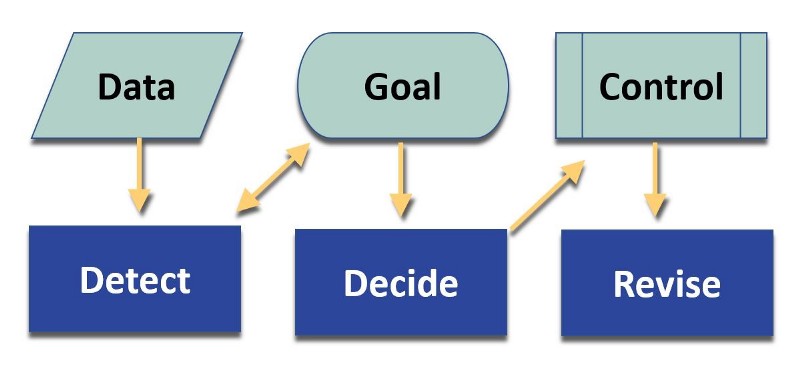Editor’s Note: This post is part of a series featuring speakers from the Marketing Artificial Intelligence Conference (MAICON). For more information, visit www.MAICON.ai. It was originally published by Jim Sterne.
Artificial Intelligence and Machine Learning are at the top of the hype cycle. To keep you in the conversation on the Slack channel, at the company retreat, or while heading to the airport with your boss, you will be well served to keep these three Needs and Deeds in mind:
Needs: Data, Goal, Control
Deeds: Detect, Decide, Revise

This nascent technology is flourishing now that there is enough computing horsepower (thank you gaming systems that needed Graphical Processing Units), enough data (thank you, Internet), and enough data scientists (thank you Tom Davenport for calling data science the sexiest job of the 21st century). Thanks also to fifty years of research and experimentation.
While Artificial Intelligence includes Speech Recognition that lets us talk to Alexa, Natural Language Processing that can assess millions of documents, and Visualization for telling cats from dogs and driving cars, it is Machine Learning that makes all the difference in marketing.
Machine Learning is the ability for the system to look at a dataset and discover the most predictive attributes for a given outcome (Detect). It can then infer rules about the data — from the data — weigh the attributes, and suggest a course of action to best achieve that given outcome (Decide). Finally, the machine can look at the results of that action and alter its opinion about the attributes and their weights (Revise).
Programmers are no longer responsible for explicitly telling the machine what do and how to handle exceptions. Instead, the stake holder defines the desired outcome and the data scientist feeds the machine the appropriate datasets. These two actions will forever remain complex problems to solve, but the machine is now responsible for considering alternatives, rather than merely executing instructions.
Need 1: Lots of DATA
Machine Learning is not going to be helpful for a small business with a small budget for marketing — yet. To be truly valuable, ML needs a lot of data. If you flip a coin and it comes out heads, you will incorrectly predict that it will always come up heads because you have a statistically insignificant amount of information.
To get the right message to the right person at the right time, the machine must learn from hundreds of thousands of examples. If you are Coke, Amazon or Proctor & Gamble, congratulations, you have a large enough marketplace. If you are not, you’ll have to wait until machine learning as a service (MLAAS) comes along — and it will.
People often underestimate just how much data machines need in order to learn. Malcom Gladwell says it takes 10,000 hours of experience for a person to master something. Machines need the same amount of input but fortunately, they can crunch through it much faster.
Need 2: Clear GOALS
Awareness? Response? Subscribers? Conversions? Pick one and your machine will oblige. But it must be very clearly defined.
If you state your goal as revenue, the machine will eventually figure out that you should sell $10 bills for $5. That will generate more revenue than Apple and Google combined in almost no time at all.
Deed 1: DETECT Significance
With a clear goal, the machine can identify the most revealing attributes in a mountain of data. Even with noisy data and a large variety of data types, it can figure out which bits to heed and which to ignore.
The machine can deduce that humidity, temperature and barometric pressure are more predictive of rain than wind speed, hours of daylight and air quality. It will detect that advertising luxury automobiles based on ZIP code, income and the state of the stock market, is more effective than age, education and height. The attributes the machine identifies as predictive need not be logical. They need not make sense, they only need to produce results.
Deed 2: DECIDE on Action
Given enough data and a clear goal, the machine can recommend a course of action. Advertise umbrellas this week. Promote your larger luxury car at lunch time. Send this sort of message to that sort of person with this type of offer.
At this point, the machine has built a model of the desired outcome based on available data and has decided on the next step. This is where the ‘intelligence’ gets interesting.
Deed 3: REVISE the Model
Once you’ve taken the machine’s advice and collected new data from the outcome of that action, the machine can reconsider its opinion and adjust accordingly. It was confident that a particular action would produce the best results. But with new data, it can build a better model and recommend a fresh action with higher confidence.
Need 3: CONTROL over Action
When you allow the machine to manage the actions it recommends — to act on its decisions — you establish a feedback loop that makes all the difference.
The machine now has all the data it needs to choose the action that best produces the desired outcome, and can then change its mind based on the result of the action taken. Rinse, repeat, ad infinitum, with tremendous speed.
Today, you wait for the end of the week for promotional data to come to your desk. You then schedule a meeting to discuss the outcomes and plan how you want to change your target, message, and spend. Next, the creative team is brought in to make requisite changes to content and style. Finally, the new iteration is ready to roll after a couple of weeks.
Tomorrow, the machine will be able to constantly offer up new creative to the proper audience at the right time, evaluate the results, and continuously improve.
Calculators have become computers and computers have become thinking machines. Your role will be to clearly define the desired outcome, decide which data might be useful, and tweak those two based on outcomes.
You job is now to decide when to utilize this new technology and closely monitor its actions to ensure it doesn’t have you selling $10 bills for $5.
Catch Jim Sterne’s MAICON workshop, "Machine Learning 101 for Marketers," to learn how to speak knowledgeably about machine learning, and stand prepared to implement it in your organization.
Jim Sterne
An internationally known speaker and consultant to Fortune 500 companies and Internet entrepreneurs, Jim has spent more than twenty years in sales and marketing and most of that on measuring the value of Digital medium for creating and strengthening customer relationships. He's authored books on Internet advertising, marketing, customer service, email marketing, web analytics, and most recently, "Artificial Intelligence for Marketing: Practical Applications."


